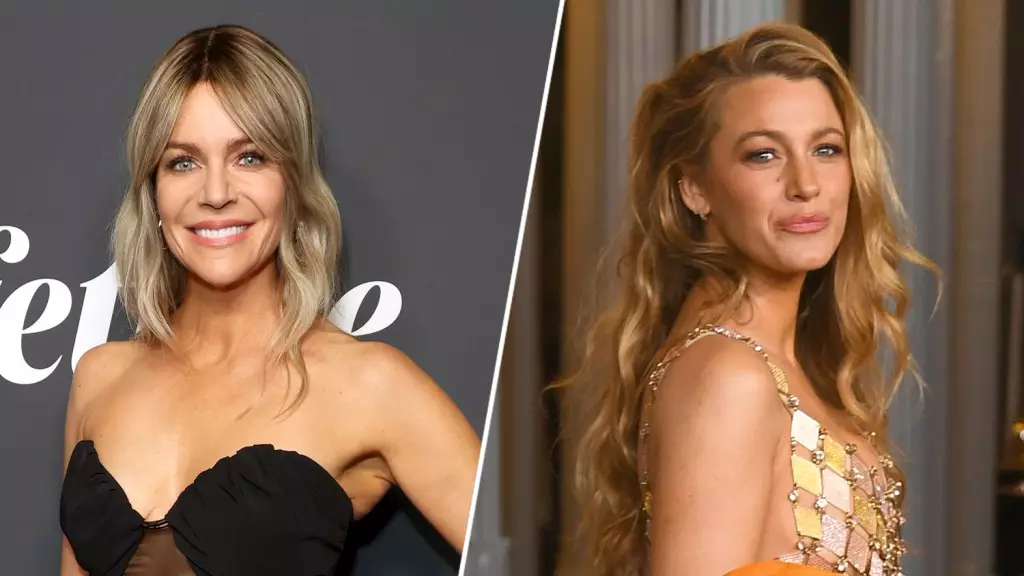In the world of Hollywood, where glitz and glamour often hide darker realities, allegations of misconduct can reverberate across the industry like shockwaves. The recent controversy surrounding Blake Lively and Justin Baldoni showcases not just personal grievances but a larger commentary on the systemic issues related to power dynamics within film and television. As Lively takes a bold stance against what she describes as a hostile work environment and retaliatory tactics, the response from fellow actors and the industry at large raises critical questions about accountability and support.
An Unexpected Ally: Support from Kaitlin Olson
Amidst this chaotic landscape, the support for Lively has been vocal, particularly from fellow actress Kaitlin Olson. Olson, a recognized talent with multiple Emmy nominations, publicly championed Lively through social media, declaring her to be “a kind, lovely, honest, and generous person.” This solidarity is noteworthy, especially considering that Olson’s husband, Rob McElhenney, co-owns the Welsh football club Wrexham A.F.C. with Lively’s husband, Ryan Reynolds. Here, the intertwining relationships in Hollywood come into play, illustrating how personal and professional ties can influence public perception and responses.
Olson’s endorsement serves not simply as a statement of support but as a rallying cry for others in the industry to join in forthright advocacy against misconduct. Her vocal stance could signal a shift in the culture, urging others in the limelight to reflect on their own experiences and the importance of amplifying voices of those affected by harassment and intimidation.
Lively’s allegations against Baldoni are serious. In a comprehensive complaint filed with the California Civil Rights Department, she outlines what she describes as a “hostile work environment” that posed a significant threat to the production of their film. This complaint goes beyond mere accusations; Lively alleges a coordinated smear campaign, intricately woven by Baldoni and his associates, aimed at damaging her reputation when she chose to speak out. This allegation exposes a sinister aspect of workplace dynamics where retaliation often punishes those who dare to raise their voices against misconduct, complicating the conversation around #MeToo and corporate accountability.
Baldoni’s response to the allegations includes vehement denials portrayed through his attorney, asserting that Lively’s claims are “completely false” and an attempt to reshape the narrative in a way detrimental to his image. Notably, the public reaction to these statements and the wider context should not be underestimated; they play a crucial role in shaping public sentiment and defining one’s career trajectory in the entertainment industry.
The legal entanglements that have emerged from this saga only serve to highlight the complexities of celebrity culture and workplace dynamics. Lively is not the only one facing the fallout; former associates like Stephanie Jones have also taken legal actions against Baldoni and his company, perhaps shedding light on the broader implications of these allegations. Jones’ lawsuit for defamation and breach of contract points to a pervasive issue within Hollywood — where roles and responsibilities are often murky, and the repercussions of misconduct can extend far beyond the individuals directly involved.
As litigation unfolds, the stakes only grow higher. Baldoni’s potential counter-lawsuit against Lively could complicate matters further, indicating a fractious battle that may echo the broader issues of truth, accountability, and the manipulation of public perception. The legal complexities also serve as a reminder of the power of narratives in shaping the discourse around harassment, leading us to question the fabric of narratives produced in media and their alignment (or misalignment) with actual events.
The unfolding drama surrounding Lively and Baldoni acts as a microcosm of the broader struggles faced in the entertainment industry. It challenges us to reconsider how we support victims, advocate for accountability, and ensure that our platforms are used to amplify the truth rather than distort it. As this situation develops, both actors and audiences alike are left to grapple with the imperative of courage and integrity in confronting powerful industry figures. Ultimately, it beckons for a more transparent and supportive environment where individuals can recount their experiences without fear of retaliation or manipulation. In a time of reckoning, the collective responsibility of the industry is at a crossroads, dictating the nature of future narratives—both on and off the screen.


Leave a Reply